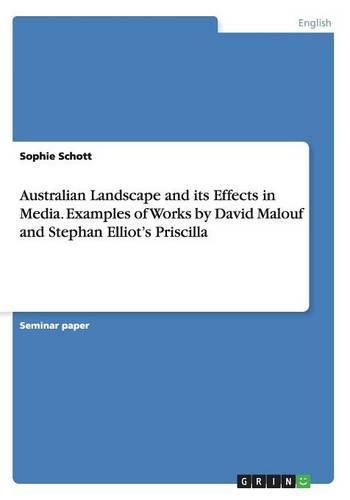Readings Newsletter
Become a Readings Member to make your shopping experience even easier.
Sign in or sign up for free!
You’re not far away from qualifying for FREE standard shipping within Australia
You’ve qualified for FREE standard shipping within Australia
The cart is loading…






Seminar paper from the year 2014 in the subject English Language and Literature Studies - Literature, grade: 1,3, University of Frankfurt (Main) (Institute for English and American Studies), course: Narrative Spaces: Land- and Cityscapes in Australian Literature, language: English, abstract: Different media can present and narrate landscapes, and these presentations evoke different reactions. There are several distinctions between the visual and linguistic demonstration of landscape that can be observed and must be considered when analysing either a written description or a pictorial representation, hence the focus is laid on differences between films and novels. A novel and a film are two separate media which utilise different methods to present landscapes. A written text leaves more room for personal interpretations, whereas a film represents really existing landscapes. The viewer has to accept the actuality of the presented pictures, which is why films limit own interpretations compared to novels. This differentiation is noticeable in the provoked feelings for the reader, respectively viewer. Examples are the short-story collections Dream Stuff (2000) and Complete Stories (2007) by David Malouf and Stephan Elliot’s film Priscilla (1994). The film is about three drag queens crossing the Australian Outback on their road trip from Sydney to Alice Springs. Malouf’s short stories deal with people of different age who experience landscape in different ways due to distinct events and circumstances. Both, the short stories and the film, present the landscape of Australia, but in totally different ways because of distinct techniques. A director makes use of varying camera angles, focuses and colours which lead to the feeling of being within the scene for the viewer. An author discloses the protagonists’ thoughts and feelings; consequently, the reader is able to empathise with them. At last, the outcomes of the first two parts are related to each other. Comparing th
$9.00 standard shipping within Australia
FREE standard shipping within Australia for orders over $100.00
Express & International shipping calculated at checkout
Seminar paper from the year 2014 in the subject English Language and Literature Studies - Literature, grade: 1,3, University of Frankfurt (Main) (Institute for English and American Studies), course: Narrative Spaces: Land- and Cityscapes in Australian Literature, language: English, abstract: Different media can present and narrate landscapes, and these presentations evoke different reactions. There are several distinctions between the visual and linguistic demonstration of landscape that can be observed and must be considered when analysing either a written description or a pictorial representation, hence the focus is laid on differences between films and novels. A novel and a film are two separate media which utilise different methods to present landscapes. A written text leaves more room for personal interpretations, whereas a film represents really existing landscapes. The viewer has to accept the actuality of the presented pictures, which is why films limit own interpretations compared to novels. This differentiation is noticeable in the provoked feelings for the reader, respectively viewer. Examples are the short-story collections Dream Stuff (2000) and Complete Stories (2007) by David Malouf and Stephan Elliot’s film Priscilla (1994). The film is about three drag queens crossing the Australian Outback on their road trip from Sydney to Alice Springs. Malouf’s short stories deal with people of different age who experience landscape in different ways due to distinct events and circumstances. Both, the short stories and the film, present the landscape of Australia, but in totally different ways because of distinct techniques. A director makes use of varying camera angles, focuses and colours which lead to the feeling of being within the scene for the viewer. An author discloses the protagonists’ thoughts and feelings; consequently, the reader is able to empathise with them. At last, the outcomes of the first two parts are related to each other. Comparing th